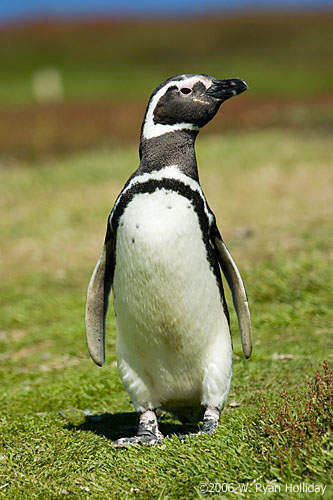Magellanic Penguin Habitat (Spheniscus magellanicus)
Magellanic Penguins are found around the coast line of Chile, Argentina and the Falkland Islands. They spend their time at sea and when they come ashore to breed they form large colonies.
Once threatened primarily by oil spills, Magellanic penguins (Spheniscus magellanicus), now face a larger threat as fish are displaced by warming ocean currents, forcing the birds to swim farther to find food. Last year hundreds of Magellanic penguins washed up on beaches around Rio de Janeiro, many emaciated or dead.
Scientists have speculated that changes in ocean currents or
temperatures, which may be related to climate change, could have been
responsible for their movement more than a thousand miles north of their
traditional nesting area in the southern tip of Argentina. Twelve out
of the 17 penguin species are currently experiencing rapid population
decline

Magellanic Penguin Breeding
Magellanic Penguins breed between September and February and they gather in large nesting colonies. They pair up for life and they construct their nests under bushes or in burrows. Two eggs are laid and they are incubated for 39 - 42 days. Both parents incubate the eggs taking it in turns for 10 - 15 days shifts. Upon hatching the chicks are cared for by both parents for one month and they are fed every 2 - 3 days.
They gain their adult plumage when they are approximately one month old and at 60 - 70 days old they are ready to head out to sea. Magellanic Penguins become sexually mature between 2 and 3 years of age.

Magellanic Penguin Predators
Predators of adult Magellanic Penguins include sea lions and their chicks are preyed upon by kelp gulls and the giant petrel.

Magellanic Penguin Main Characteristics.
Magellanic Penguins are between 70 and 76 cms (28 - 30 inches) in height and they weigh between 4 and 6 kgs (8.8 and 13 lbs). They are coloured black/dark grey on their back and white on their front. They have a distinctive, black, horseshoe shaped band on their front and a thick black band that runs under their chin.
Their tail is short and wedge shaped and they have long, narrow wings that they use like paddles when swimming. They are excellent swimmers and can swim at speeds over 24 km/hr (15 mph).
During periods of warmer weather Magellanic Penguins lose their feathers around their eyes. As the weather becomes colder, their feathers grow back once again.












0 comments:
Post a Comment